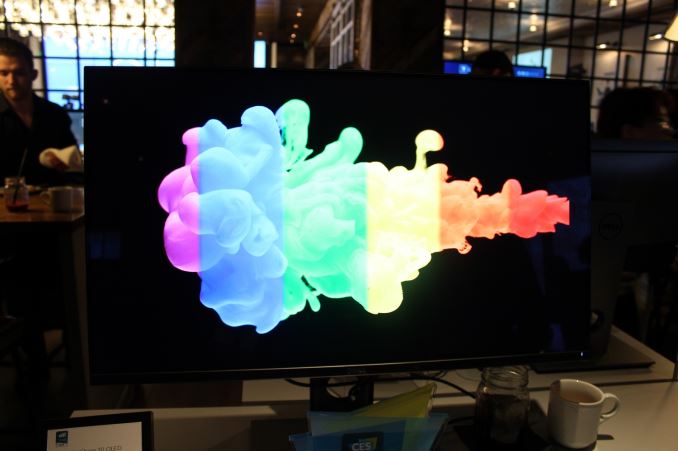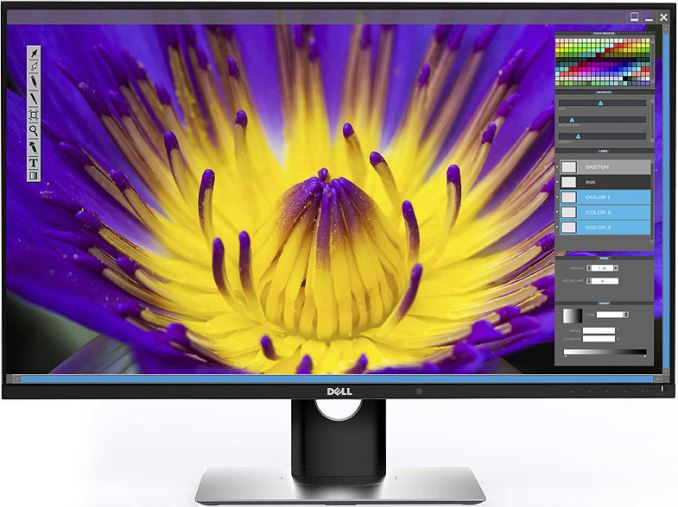Dell Demonstrates 30-inch 4K OLED Display
by Anton Shilov on January 7, 2016 6:40 PM EST- Posted in
- Monitors
- Dell
- Trade Shows
- 4K
- Ultrasharp
- CES 2016
- 30"
- OLED
- UP3017Q

Dell does not produce its own display panels, but when it comes to unique “world’s first” monitors, it is sometimes years ahead of all of its rivals. At the International CES 2016, Dell introduced its UltraSharp 30-inch OLED display, the company’s first monitor to use organic light emitting diode panel. The product is designed for professionals and carries a rather extreme price tag, but this is going to be a dream display for years to come.
The Dell UltraSharp UP3017Q is a 30-inch display with 3840×2160 resolution, 0.1 ms response time and an unknown refresh rate (yet, it should be very high). The monitor can reproduce 1.07 billion colors, it covers 100% of Adobe RGB color space as well as and 97.8% of DCI-P3 color space (used for digital movie projection by the U.S. movie industry and is expected to be adopted in televisions and in home cinema), according to Dell. Just a few professional displays nowadays cover 100% of Adobe RGB. The manufacturer declares 400,000:1 dynamic contrast ratio, but admits the value is only that because testing equipment won't go higher.
The UltraSharp UP3017Q ultra-high-definition display has very narrow bezels; the monitor itself is thin, but not remarkably thin like OLED TVs, possibly because it features internal power supply unit as well as complex logic inside. The monitor features a mini DisplayPort (mDP) connector, an HDMI port as well as a USB type-C port, which could be used for video and data connectivity as well as for power delivery (it can be powered using a type-C cable, or deliver power to another device).
Emissive electroluminescent layer in organic light-emitting diode is made of organic compound that emits light in response to an electric current. The organic semiconductor layer is situated between two electrodes and does not require a backlight. As a result, it can display truly deep black levels, unlike liquid crystal display (LCD) panels, which use various kinds of backlighting. Besides, since the emissive electroluminescent layer is very thin and can take different shapes, it is possible to build ultra-thin and even curved monitors and TVs using OLEDs.
While OLED technology can deliver deep blacks, high contrast ratio and exceptional colours, it is not free of drawbacks. The organic layer may burn down over prolonged amount of time, and colors can shift over time. To maximize lifespan of the OLED panel inside the UltraSharp UP3017Q, Dell integrated a special presence detector into the front panel of the display, which switches the monitor off when nobody uses it. Another disadvantage of OLEDs is a possibility of static image burn in. To reduce the chance of burn in, the UP3017Q has a special pixel-shifting technology.
The Dell UltraSharp 30 OLED monitor will cost whopping $4,999, which it becomes available on March 31, 2016, in the United States. The display at this point is only aimed at professionals, who work in color-critical environments such as graphic arts and photography. However, due to exceptional colors and contrast as well as ultra-fast response time, the UltraSharp UP3017Q will be a dream display for gamers, prosumers and other users, who value quality.
OLED panels are considerably more expensive to produce than modern LCD panels, partly because of lower yields. Last year an executive from LG Electronics said that yields of OLED panels had reached 80% and would continue to grow. At the International CES 2016, Kwon Bong-suk, the head of LG’s TV business, said that the company had cut prices of OLED TVs in the U.S. by 45% late in 2015. As a result, LG now expects sales of OLED televisions to triple this year. Price reduction of OLED TVs indicates that production costs of organic light-emitting diode panels are going down. Perhaps, over time, the Dell UltraSharp UP3017Q will also become more affordable, or Dell will release an OLED display for a wider audience.











83 Comments
View All Comments
The Deutsch Thinker - Thursday, January 7, 2016 - link
Wow, I've been waiting to see a large OLED display for so long now! Yay!nathanddrews - Friday, January 8, 2016 - link
Yeah, but look at the horrible banding in that first shot. ;-)http://images.anandtech.com/doci/9923/DellOLED_678...
dananski - Sunday, January 10, 2016 - link
Hahaha! xDddriver - Friday, January 8, 2016 - link
Now make a curved 21:9 one at 2x4k resolution no larger than 40 inches and I am in.8steve8 - Wednesday, February 3, 2016 - link
21:9, ew. 16:10 please.. or even squarer.ericorg - Saturday, February 20, 2016 - link
21:9? Dear god, You don't deserve an OLED display.Samus - Thursday, January 7, 2016 - link
Dopeaustinsguitar - Thursday, January 7, 2016 - link
cmon! plz stop this 4k nonsense. maybe 5 years from now when modern tech is okay enough for itPLEASE GIVE ME MY 1440P 28 INCH OLED 120 HZ MONITOR NOW PEOPLE!!!
dragonsqrrl - Thursday, January 7, 2016 - link
Hate to have to state the abundantly obvious, but something like this isn't targeted at you. This is for content creation and photo/video work where the resolution is more than welcome for editing and authoring high res content, and the hardware is already very capable of doing so.austinsguitar - Thursday, January 7, 2016 - link
I hole-heartedly understand that. but i get sick and tired of display manufacturers giving us the big stick and holding off tech that(lets be serious people would buy it in a second) technology like the monitor i mentioned from being created. 4k is retarded. its retarded in tv's and in monitors. i understand this isn't being put out for me, im not a professional detailed creator in a factory space. but the whole thing is a fad. these manufacturers are making terrible mistakes by completely jumping from 1080p to 4k. that is a massive leap and most people don't even know of any resolutions inbetween. its just sick and i feel they are really stickler-ing people into SH$@ they never will appreciate. sorry this just really bugs me.